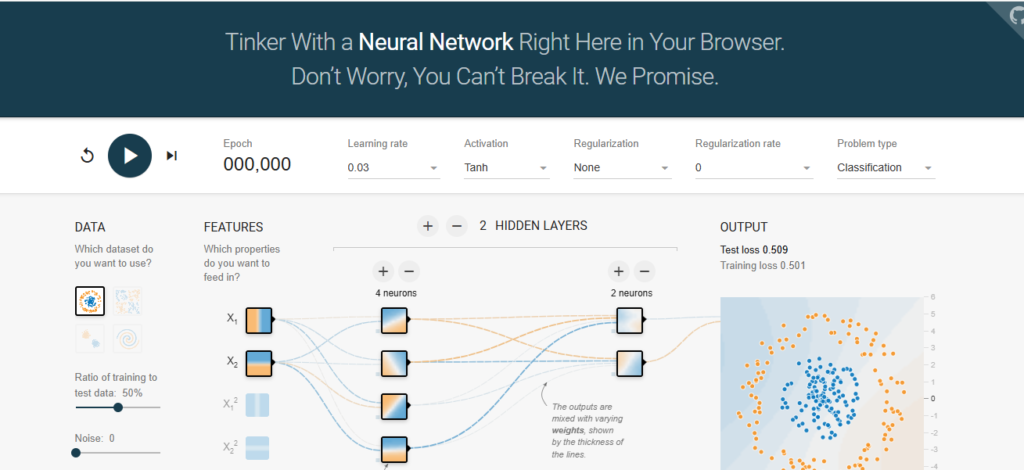Machine learning (ML) can seem tough, especially with complicated models like deep learning networks. But what if you could actually see how they work and try them yourself? There are plenty of interactive tools and websites that make learning ML easier and more fun. Whether you’re just starting or already know a bit, these tools let you play around with concepts and see how they work.
Want to know which ones? In this blog, I’ll share some of the best interactive resources to help you learn ML simply and practically.
1. MLU-Explain: A Resource for Machine Learning Explanations
Website: mlu-explain.github.io
Overview:
MLU-Explain is a fantastic resource dedicated to simplifying the core concepts of machine learning through easy-to-understand explanations. It provides a collection of visual and interactive tools that aim to demystify complex machine learning models and algorithms.

Key Features:
- Detailed Explanations: MLU-Explain provides a wealth of articles breaking down various ML topics, including supervised learning, unsupervised learning, and neural networks.
- Interactive Visualizations: The site includes visual aids that help explain concepts like decision trees, support vector machines, and clustering algorithms, making it easier for users to grasp how these models function.
- Hands-On Learning: Users can experiment with model parameters, adjust hyperparameters, and see in real time how changes affect outcomes.
Best For:
MLU-Explain is ideal for beginners who want to learn machine learning from scratch or intermediate learners seeking visual explanations for more complex topics. Its clear and engaging presentation of key concepts makes it a great starting point.
2. TensorSpace: Visualize Neural Networks in 3D
Website: tensorspace.org
Overview:
TensorSpace is an open-source library that allows users to visualize neural networks in a 3D space. This interactive platform supports deep learning models built with TensorFlow, Keras, and TensorFlow.js, allowing users to manipulate, observe, and interact with different layers of a neural network.

Key Features:
- 3D Network Visualization: TensorSpace presents neural networks in an intuitive 3D format, enabling users to see how data flows through the network.
- Layer Interaction: Users can interact with individual layers, viewing inputs, outputs, and weights at each step of the process.
- Real-Time Updates: As users experiment with different model structures, TensorSpace updates the visualizations in real-time, providing an immediate understanding of how changes affect the network’s performance.
Best For:
TensorSpace is excellent for learners who want to understand how neural networks function under the hood. By offering a clear, 3D visualization of deep learning models, it’s particularly useful for visual learners and those who struggle with abstract representations of neural networks.
3. Transformer Explainer: Understanding Transformer Models
Website: poloclub.github.io/transformer-explainer
Overview:
Transformer models, like GPT and BERT, have revolutionized natural language processing (NLP), but their complexity can make them hard to understand. Transformer Explainer is a web-based tool that simplifies the inner workings of transformers, making it easier for users to understand how these powerful models process and generate text.

Key Features:
- Interactive Visualizations: Users can explore how input tokens move through the attention layers of the transformer model.
- Step-by-Step Breakdown: The tool breaks down how transformers process input text, showing users how different attention heads capture various linguistic features.
- Hands-On Exploration: Users can input their text and observe how the transformer handles it, providing real-time insights into model behaviour.
Best For:
Transformer Explainer is perfect for learners who want to understand the mechanics of transformer-based models like BERT and GPT. It’s especially useful for NLP professionals who need to grasp how transformers handle language tasks such as translation, summarization, and text generation.
4. TensorFlow Playground: Neural Network Playground for Beginners
Website: playground.tensorflow.org
Overview:
TensorFlow Playground is an excellent web-based tool that allows users to experiment with neural networks in an intuitive and fun way. You can build, train, and visualize small neural networks directly in the browser, making it a fantastic tool for learning the basics of neural networks.

Key Features:
- Interactive Interface: Users can adjust hyperparameters like learning rate, activation functions, and layer size to see how these factors influence the model’s performance.
- Real-Time Feedback: As you tweak parameters, the network immediately reflects changes, providing real-time visual feedback on the learning process.
- Visualization of Decision Boundaries: Users can see how the neural network learns to separate different classes in a dataset, offering insight into how decision boundaries are formed.
Best For:
TensorFlow Playground is ideal for beginners who are just starting with neural networks. It offers an engaging and interactive way to understand basic concepts like activation functions, learning rates, and overfitting without requiring any coding experience.
Conclusion
Interactive tools are invaluable resources for learners at all levels who want to deepen their understanding of machine learning. From TensorSpace’s 3D visualizations to TensorFlow Playground’s real-time experimentation, these platforms provide a hands-on approach to learning that complements traditional reading and coursework.
Each of these tools offers unique advantages, depending on your interests and skill level:
- MLU-Explain is great for learners who need a solid theoretical foundation with visual aids.
- TensorSpace helps users understand the intricate workings of deep learning models in a 3D environment.
- Transformer Explainer is the perfect resource for those who want to understand advanced NLP models like transformers.
- TensorFlow Playground provides an intuitive interface for experimenting with basic neural networks.
By leveraging these interactive platforms, you can go beyond the theoretical and truly experience machine learning concepts. Dive in, experiment, and enjoy the journey!

